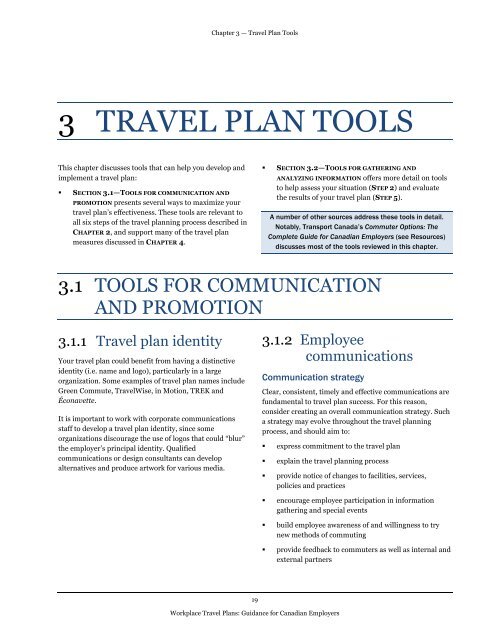Workplace Travel Plans - main body - Final Jan 2010 ENGLISH - FCM
Workplace Travel Plans - main body - Final Jan 2010 ENGLISH - FCM
Workplace Travel Plans - main body - Final Jan 2010 ENGLISH - FCM
Create successful ePaper yourself
Turn your PDF publications into a flip-book with our unique Google optimized e-Paper software.
Chapter 3 — <strong>Travel</strong> Plan Tools<br />
3 TRAVEL PLAN TOOLS<br />
This chapter discusses tools that can help you develop and<br />
implement a travel plan:<br />
! SECTION 3.1—TOOLS FOR COMMUNICATION AND<br />
PROMOTION presents several ways to maximize your<br />
travel plan’s effectiveness. These tools are relevant to<br />
all six steps of the travel planning process described in<br />
CHAPTER 2, and support many of the travel plan<br />
measures discussed in CHAPTER 4.<br />
! SECTION 3.2—TOOLS FOR GATHERING AND<br />
ANALYZING INFORMATION offers more detail on tools<br />
to help assess your situation (STEP 2) and evaluate<br />
the results of your travel plan (STEP 5).<br />
A number of other sources address these tools in detail.<br />
Notably, Transport Canada’s Commuter Options: The<br />
Complete Guide for Canadian Employers (see Resources)<br />
discusses most of the tools reviewed in this chapter.<br />
3.1 TOOLS FOR COMMUNICATION<br />
AND PROMOTION<br />
3.1.1 <strong>Travel</strong> plan identity<br />
Your travel plan could benefit from having a distinctive<br />
identity (i.e. name and logo), particularly in a large<br />
organization. Some examples of travel plan names include<br />
Green Commute, <strong>Travel</strong>Wise, in Motion, TREK and<br />
Éconavette.<br />
It is important to work with corporate communications<br />
staff to develop a travel plan identity, since some<br />
organizations discourage the use of logos that could “blur”<br />
the employer’s principal identity. Qualified<br />
communications or design consultants can develop<br />
alternatives and produce artwork for various media.<br />
3.1.2 Employee<br />
communications<br />
Communication strategy<br />
Clear, consistent, timely and effective communications are<br />
fundamental to travel plan success. For this reason,<br />
consider creating an overall communication strategy. Such<br />
a strategy may evolve throughout the travel planning<br />
process, and should aim to:<br />
! express commitment to the travel plan<br />
! explain the travel planning process<br />
! provide notice of changes to facilities, services,<br />
policies and practices<br />
! encourage employee participation in information<br />
gathering and special events<br />
! build employee awareness of and willingness to try<br />
new methods of commuting<br />
! provide feedback to commuters as well as internal and<br />
external partners<br />
19<br />
<strong>Workplace</strong> <strong>Travel</strong> <strong>Plans</strong>: Guidance for Canadian Employers

















